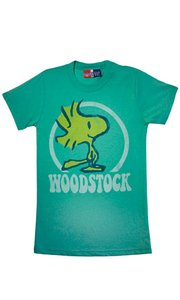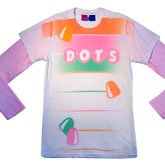Junk Food Strikes Deal with GapKids
GapKids division debuts collaboration with Los Angeles–based T-shirt label
Junk Food Clothing is gambling on a new partnership with Gap Inc.
On Nov. 14, the popular Los Angeles–based vintage, graphic T-shirt designer will debut a collaboration with the San Francisco–based retailer’s GapKids division. The collaboration will sport the moniker Junk Food Loves GapKids.
The collaboration will be tested in 131 GapKids stores across the United States. The retailer will prominently merchandise the Junk Food Loves GapKids line on speed tables devoted to the line.
The collaboration includes 36 SKUs—half for girls and half for boys. Retail price points range from $22.50 to $26.50, and sizes range from 4 to 16. The tees will bear graphics from licenses such as Hello Kitty, Peanuts, D.C. Comics and “Star Wars.” If Gap judges it a success, the line will be rolled out to the 600 locations of its GapKids fleet. “Graphic tees are one of the hottest trends in children’s apparel right now,” said Pam Wallack, president of babyGap and GapKids, in a prepared statement. “Junk Food’s vintage designs are something that both kids and their parents connect with.”
Designer collaborations have been a popular category for the Gap over the past year. In April, the $15 billion retailer of stylish but basic clothes raised eyebrows with the debut of a limited collection of white T-shirts and dresses created by emerging designers Rodarte, Doo-Ri Chung and Thakoon Panichgul. In September 2006, the retailer offered a capsule collection created by United Kingdom–based designer Roland Mouret. Collaborations between established retailers and stylish fashion designers have been popular for more than five years since Isaac Mizrahi made a splash with his collection for mass retailer Target. The collaborations typically result in building a cachet for the retailer. The payoff for the designer often is a better distribution in the retail market.
While designer collaborations are a popular feature at discount retailers including H&M and Target, they are still uncommon for Gap Inc. Industry watchers wondered if collaborations could revive the fortunes of the flailing retailer. Gap Inc.’s comparable-store sales for its third quarter, which ended Nov. 4, declined 5 percent compared with the third quarter of its 2006 fiscal year. Its same-store sales for the month of October declined 8 percent.
Mercedes Gonzales, director of New York–based fashion forecasters and buying office Global Purchasing Cos., said that Gap has not been aggressive enough when it comes to reinventing its business.
“Junk Food is a hot brand,” Gonzales said. “But will it rejuvenate Gap? I doubt it.”
However, the high-profile collaboration also has the potential to push the T-shirt label into the realm of a lifestyle brand. It’s the industry brass ring where a label can cross over to multiple clothing and accessories categories, said Blaine Halvorson, founder and creative director of Junk Food. “What it could do for brand recognition is incredible,” he said of the collaboration.
Halvorson and Natalie Grof, the label’s co-founder and chief executive, said that they were considering developing their successful T-shirt line into other categories such as denim and homewares as well as perhaps opening a branded boutique in an overseas location such as Tokyo. The Gap collaboration could shine a spotlight on an already-popular label.
The Junk Food label has been in the vanguard of T-shirt designers for the past decade. Jennifer Aniston wore Junk Food’s “Cookie Monster” T-shirt during the last episode of the TV series “Friends” in 2004. However, the exposure on one of the highest-rated episodes on TV was just the proverbial icing on the cake for the T-shirt label.
Junk Food had been skyrocketing to popularity since Grof and Halvorson started the label as a two-person company in 1998. They offered graphics of nostalgic pop-culture licenses such as the children’s TV show “Sesame Street” and the game Twister in T-shirt bodies that avoided the box-like fit then common among T-shirt makers. Junk Food was profitable in its first year.
In 2005, when Duluth, Ga.–based T-shirt manufacturer Delta Apparel Inc. purchased Junk Food for $27 million, Delta expected Junk Food to add more than $33 million in sales to the company in 2006, according to Delta’s financial statements. As of November 2007, there were more than 40 employees at Junk Food.
Junk Food Clothing products are sold at more than 4,000 stores across the world. High-profile boutique Intuition, based in Los Angeles, reported success with this line, according to Jaye Hersh, Intuition’s owner.
“The original pull was the nostalgic draw of the graphics. It reminded parents of their childhoods,” Hersh said. Price also is a factor. Junk Food T-shirts retail under $30, while many other vintage, graphic T-shirts vendors start wholesaling their shirts for more than $40.
There will be some overlap between Junk Food’s collaboration with GapKids and Junk Food’s own children’s line, which it launched in 2005, Grof said. However, the Gap collaboration line will offer styles and Hello Kitty– and Peanuts-licensed graphics not used in the Junk Food kids’ line.
A desire to appeal to everyone was at the root of the label’s name. Everybody likes junk food, according to Halvorson and Grof.
For the past two years, they have worked at a 10,000-square-foot facility in West Los Angeles decorated with paintings and prints from Los Angeles artist Camille Rose Garcia and iconic posters from rock band Sex Pistols. The offices also are a playground for the business partners’ dogs Rocky, Oscar and Dirk.
Grof, who worked as a designer for a golf label before launching Junk Food, designed the bodies of the adult T-shirts to appeal to a wide market. The bodies would not be too long or too narrow. They also were meant to be worn during a night out as well as lounging around the house.
Halvorson, who launched his career in 1994 by making dresses out of mats from the game Twister, is in charge of the graphics.
Junk Food has a library of more than 40,000 designs, and Halvorson designed new looks for popular licenses such as the Smurfs, “Star Wars” and board games such as Candyland.
There is no formula for developing Junk Food’s graphics, Grof said. But Halvorson often works on his designs by taking something familiar, such as a graphic of a candy wrapper or a character like Darth Vader, and placing the graphic with a novel detail such as a new background.
The combination of new looks for old properties and comfortable T-shirt bodies garnered Junk Food shelf space in department stores including Bloomingdale’s as well as boutiques including Los Angeles–based Kitson. Junk Food did a collaboration in 2006 with Robertson Boulevard–based Kitson called Junk Food Loves Kitson.
Junk Food’s founders said that they rejected other collaboration offers until buyers from GapKids contacted them in February 2007.
The buyers offered to brainstorm with Junk Food to see if they could develop a project. The retailer and the label held talks until July, when the label received an order to develop a product for the retailer. Before the product shipped, all of the top Gap executives mulled over the new project and gave their approval to it.
Despite the executive approval, the project still holds an element of risk, Halvorson said. “You only get one chance to make it right,” he said. “We want to have longevity with this.”
























